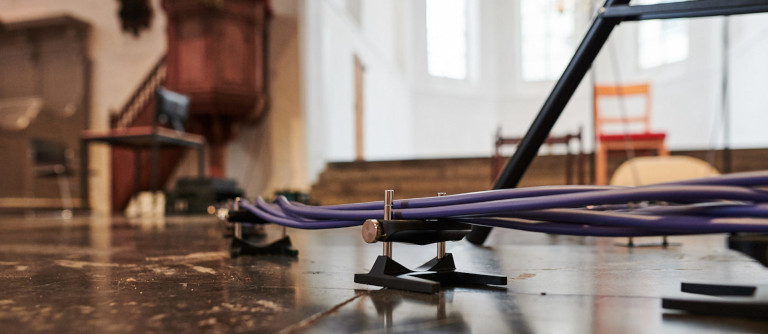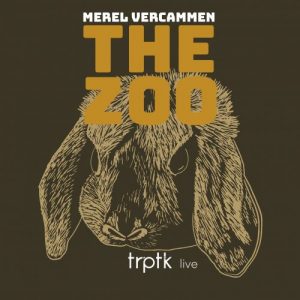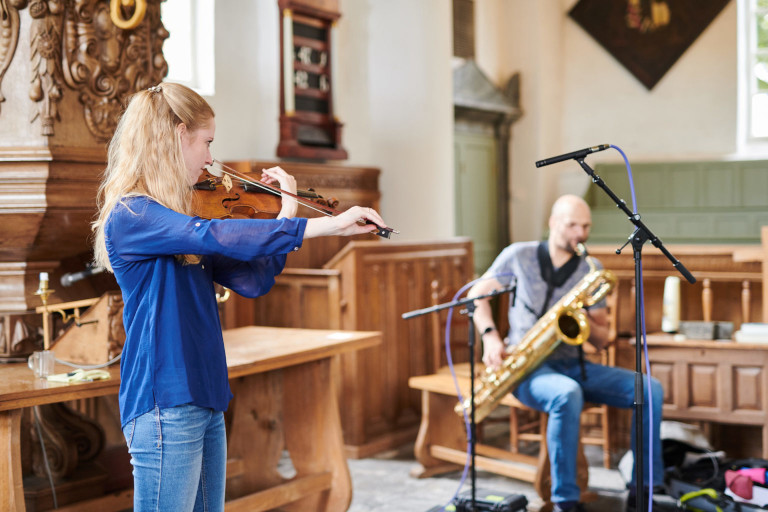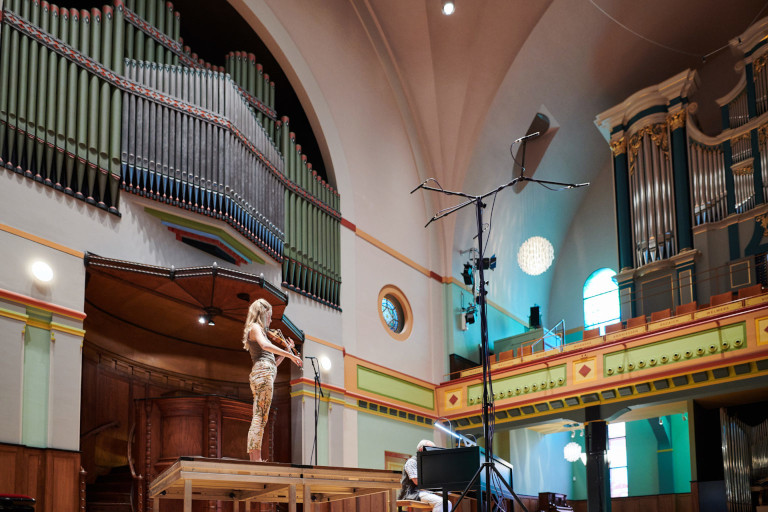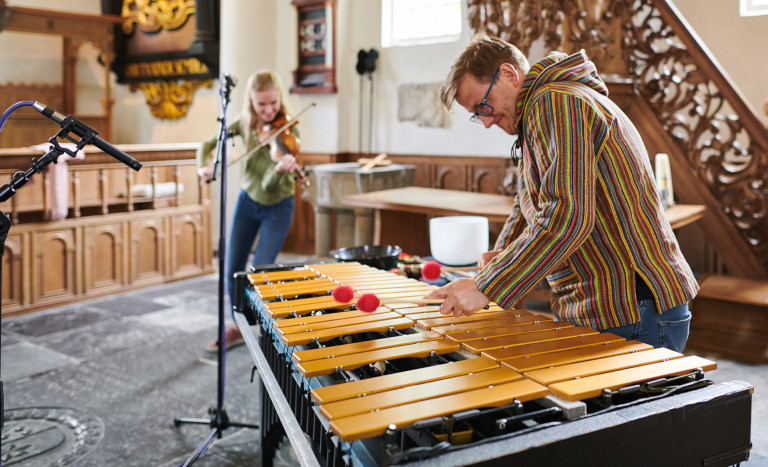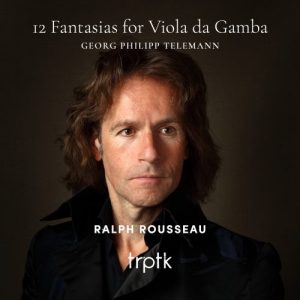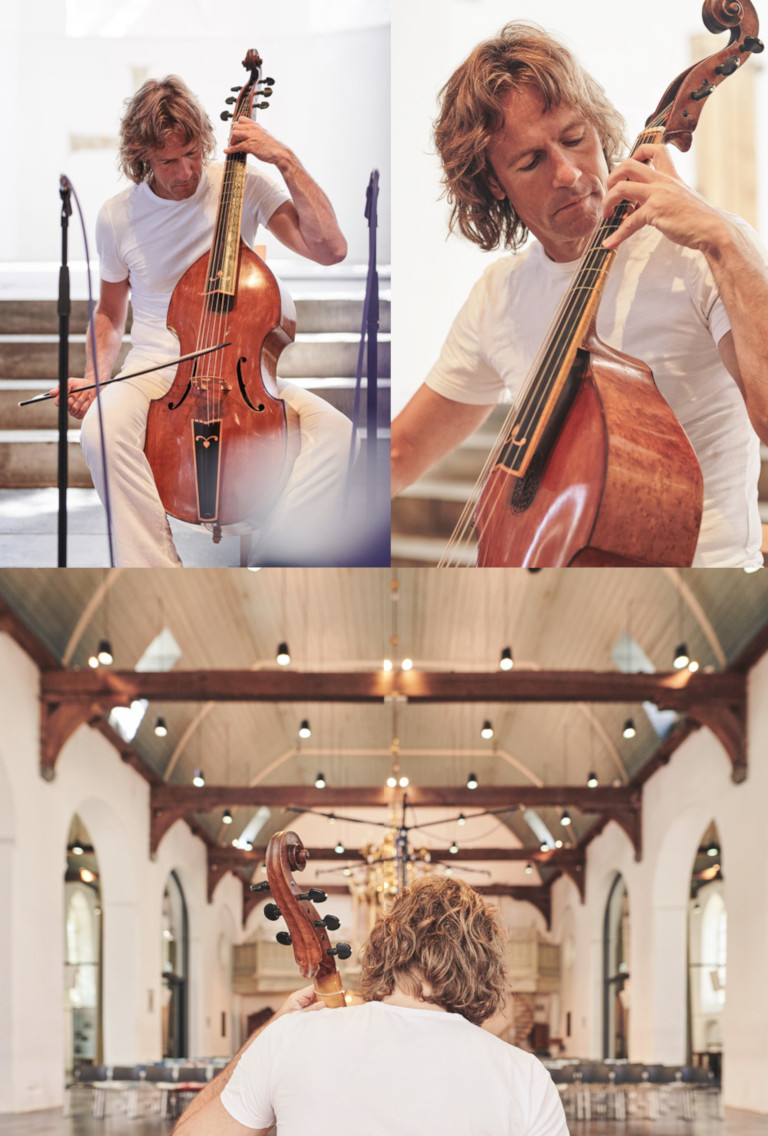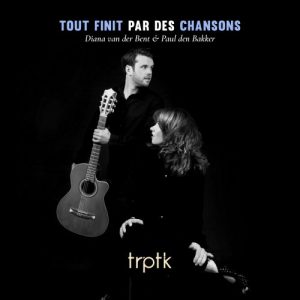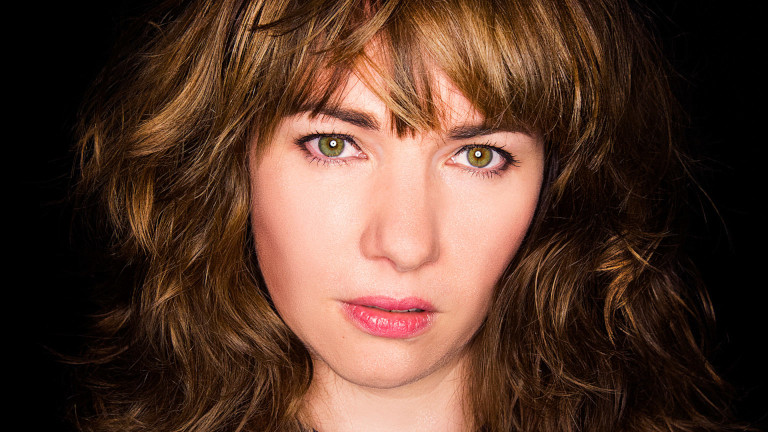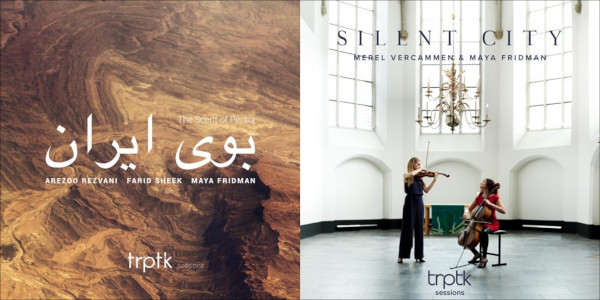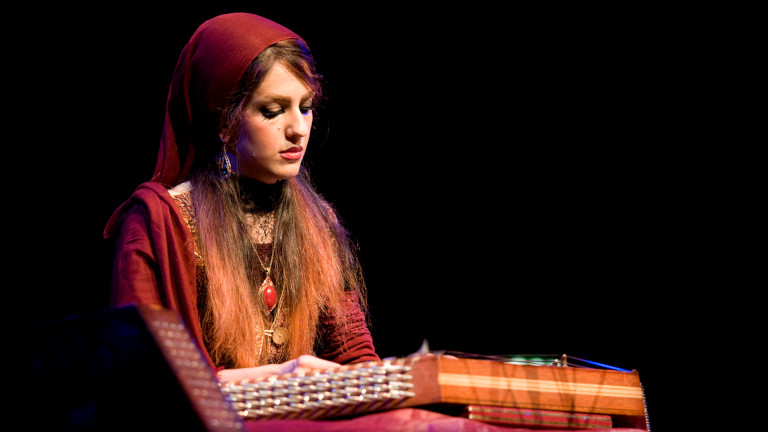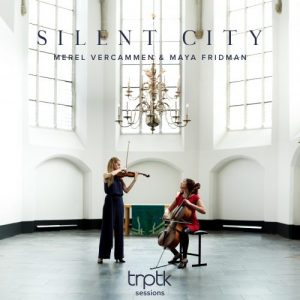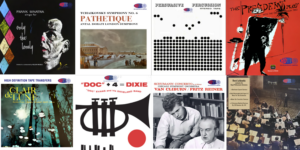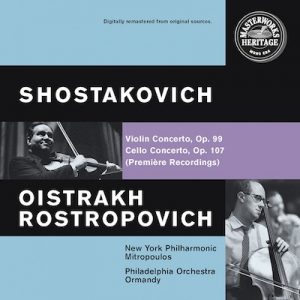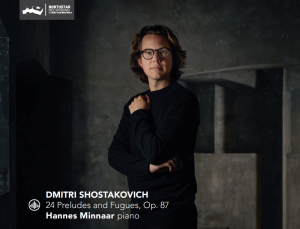The more I listen to the recordings created by Brendon Heinst and his team, the more enchanted I become. TRPTK has easily become a favorite music label in this household because of the highly varied and non-traditional repertoire, extraordinarily good artists (whom we may not know by name but are very deserving of our attention), and heroic commitment to the craft of making exceptionally natural, accurate and transparent recordings that honor the music.
As I was beginning my journey into hi res digital recordings, TRPTK was one of the labels that caught my ear. As I listened to more of their recordings, I consistently found the sound quality of their releases in the top tier of recordings that were getting me excited about the prospects for high resolution digital recording quality. The microphone technique is minimalist; the sound immediate, transparent, and neutral; and the sense of listening to real acoustic instruments being performed in a natural acoustic environment compelling.
Recording The Zoo in Oude Sint-Victorkerk in Batenburg
Brendon Heinst says of his goals,
"At TRPTK, we strive to preserve the emotional impact of the music by drawing a drastically transparent path from the artist to the listener, by using state of the art custom-built equipment and a passion for the absolute best quality in sound."
Yes, indeed there are not many recording sessions where you'll spot cable lifters in use supporting the microphone cables! (See Roger Skoff's recent article reprising cable lifters.)
Furutech NCF Booster Signal units in use to elevate microphone and power cables while recording 12 Fantasias for Viola da Gamba.
I'd like to introduce you to six releases from TRPTK that, for me, demonstrate that they are accomplishing the challenging objectives Brendon set for his recording label.
- The Fiery Angel - Maya Fridman & Artem Belogurov
- The Zoo - Merel Vercammen and friends
- Telemann: 12 Fantasias for Viola da Gamba - Ralph Rousseau
- Tout Finit Par Des Chansons - Diana van der Bent & Paul den Bakker
- The Scent of Persia - Arezoo Rezvani
- Silent City - Merel Vercammen and Maya Fridman
Serge Prokofiev: The Fiery Angel [arranged for piano and cello by Maya Fridman] - Maya Fridman & Artem Belogurov. TRPTK 2018 (DXD) (HERE)
Find some quiet time, turn off anything that makes noise, turn out the lights, and listen to this again. This is what I thought to myself after listening to this recording for the first time. And so I did, and so do I recommend to you. This is music that deserves one's full attention without distraction.
Prokofiev's The Fiery Angel is an opera for full orchestra and voice based on a novel by Valery Bryusov which depicts a love triangle between a passionate young woman, a knight, and the fiery Angel. It tells the story of the knight's attempts to win the love of a maiden whose spiritual integrity is seriously undermined by her participation in occult practices. Bryusov begins thusly:
The Fiery Angel or a True Story in which is related of the Devil, not once but often appearing in the Image of a Spirit of Light to a Maiden and seducing her to Various and Many Sinful Deeds, of Ungodly Practices of Magic, Alchemy, Astrology, the Cabbalistical Sciences and Necromancy, of the Trial of the Said Maiden under Presidency of his Eminence the Archbishop of Trier, as well as of Encounters and Discourses with the Knight and thrice Doctor Agrippa of Nettesheim, and with Doctor Faustus, composed by an Eyewitness.
So who could resist this plot? Certainly not Prokofiev. Written between 1922 and 1927, Prokofiev considered the work his masterpiece. Unfortunately, except for a concert version of two scenes from Act II, it was never staged during his lifetime. Prokofiev was reluctant to let the music languish unperformed and, after hearing a concert performance of this second act given by Serge Koussevitzky in June 1928, he adapted parts of the opera to make his Symphony No. 3 later that year.
In this recording we have neither the opera nor the concert performance, instead we have an arrangement for cello and piano that works marvelously well.
Recording session for The Fiery Angel with Maya Fridman and Artem Belogurov
This arrangement was created by the cellist in this performance, Maya Fridman, who writes:
"The idea of this work came to me in December 2014—I knew what I wanted to find: the depth embracing the light and the dark, a story that could transcend time and language, music itself. Going back to December I was sharing my ideas with my mother, when she spontaneously suggested to arrange Prokofiev's The Fiery Angel. The prospect of working on this piece thrilled me and at the same time seemed impossible."
Artem Belogurov, pianist, further clarifies the challenges in making this arrangement:
"Arranging an orchestral piece for cello and piano presents the obvious challenge of transmitting orchestral colours and texture to these two instruments. Arranging an operatic work makes the task that much more difficult. Maya made the arrangement with great acumen and care for preserving as much as possible of the original. My only contribution was an occasional reconciliation of her score with keyboard topography and pianists' abilities (in this case my own).
"A good portion of the cello part is dedicated to the vocal parts in the opera. What instrument can be better suited to imitating the human voice than the cello—from the self-assured bass of the knight to the possessed and often hysterical maiden? The role of the orchestra is thus mostly in the hands of the pianist. The player's challenge here is to reproduce an incredibly wide range of colours, textures, and the whole gamut of emotions Prokofiev invokes in the opera, without drowning the cello, while preserving clarity."
Maya Fridman's arrangement could not be more true to Prokofiev's conception of this work. It captures the story compellingly using the voices of only two instruments yet never compacts the work. The performance here is expansive, vibrates with energy, radiates passion and fully compels this listener.
And if the role of the orchestra is mostly in the hands of the pianist, how to achieve the transparency required to articulate all the different colors and textures? The answer, in part, is choice of instrument. Rather than using a modern concert grand piano with its crossing strings that introduce harmonic interactions, our artists selected instead to use a straight-strung Érard piano from 1880 that has, according to pianist Belogurov, "a more transparent and lighter sound, more color differences between registers, and quicker to respond to the touch than the concert grands of today."
Overhead photo showing the straight-strung strings of the Érard Grand Piano in the collection of The Smithsonian's National Museum of American History (HERE)
The piano used in the recording was, of course, not the piano above from The Smithsonian. The piano in the recording is an Érard provided by Frits Janmaat of Maison Érard, Amsterdam, that was played by Mahler and Dutch composer Diepenbrock.
The recording was engineered by Brendon Heinst who explains that he used a main microphone system of three Sonodore RCM-401 60V active-powered microphones, and the BLM-21 (also by Sonodore) boundary layer microphones for the surround in the multi-channel release of this title. Says Brendon, "These Sonodore microphones provide a very clear and natural transparency, making them perfect for a recording like this. The cello was aided a little bit by a Sonodore MPM-81 solid-state large diaphragm condenser microphone, which has a similar sound to the RCM-401 but with a bit more body to it. During the final mixing stage, we actually ended up almost not using this cello microphone due to the main system picking it up perfectly, but there were some places where it helped to have it very softly in the mix."
As you may have guessed by my leading off with this title, I am very impressed by this performance and recording. It is challenging music. It is exceptionally well performed. The arrangement for just two instruments works brilliantly.
As Andrew Quint wrote in The Absolute Sound, July 2018, "The music is, variously, brutal, passionate, and desperate, with the two performers negotiating these emotional hairpin curves fearlessly. Sonically, this is the first chamber music I've hear that rivals my #1 reference of over 20 years... . The players are eerily present in your room, the cello in front of the keyboard, dimensional and correctly scaled."
And I concur. The recording is transparent, richly detailed, and with excellent capture of the fairly dry acoustics of Studio 2 at MCO, Hilversum the Netherlands, which Brendon points out "is perfect for when you don't want to much reverb." If you like Prokofiev, or if you like cello, or if you just like superbly well recorded music, you should definitely put this recording on your to purchase list!
The Zoo (improvisations for violin and various partners) - Merel Vercammen and friends. TRPTK 2019 (DXD) (HERE)
The Zoo is a double album of free improvisations recorded by violinist Merel Vercammen with eight duo partners. Each work is violin with one of the eight different partnering instrumentalists (and vocalist in two of pieces). The works are "instant compositions at the time of performance, the names for the individual tracks came only after," says Vercammen, "It's not programmatic music: the music itself was there first."
Merel Vercammen recording duo improvisations with Ties Mellema on baritone saxophone.
"When listening back to all the takes in an effort to choose which ones would make it onto the album, I noticed more and more animal terms in my notebook. Some takes reminded me of elephants, deep sea creatures, or my own bunny…The album became a zoo, one without chains or cages, a garden where every animal can move about freely."
So, Vercammen named the album The Zoo. The cover drawing reflects the work "Melancholic Rabbit," an improvisation with cellist Maya Fridman. Other tracks are named for the animal that came most readily to mind after listening to the recordings, from Funky Iguana to Elephants to Armenian Mountain Viper to Black Rhinoceros to Mountain Gorilla—25 in all for 130 minutes of crazy fun and challenging musicianship. (Yes, it's a double album.)
The recording was made over five days at two recording locations, a small 15th Century church in Batenburg named Oude Sint-Victorerkerk, and the Orgelpark in Amsterdam which houses a large selection of organs and historical pianos and is a performing venue.
Brendon Heinst, founder and chief recording engineer for TRPTK, says recording this album over five days in two different locations with eight different accompanists was challenging "because here's the thing: we took on the job of making an album with eight completely different duos that still had to sound, well, together. Even though you have these eight completely different instruments sitting next to Merel, you still had to make it playable, keeping Merel in the same place in the sound stage, keeping her sound very consistent across the board, and then fitting the other instruments around it. This took lots and lots of preparations, calculation and simulation. This also meant that we had to mix everything in a way that the violin stays exactly in the same place with the same sound, not changed by the channel bleed of another microphone (this gets really tricky really fast!)."
Note the position of the main microphone array in front of and above the performers. It is the positioning of this microphone array to which Brendon refers when he says maintaining it in the same position relative to the violinist was critical.
Brendon calls his main microphone system an Optimised Omnidirectional Array (OOA) of five omnidirectional DPA d:dicate 4006A microphones. The front three microphones (facing us) capture the primary image for the stereo recording, the rear two microphones capture the ambient field for a multichannel release.
Reminiscent of the Decca tree, eh?
Oh, and did Brendon say the violin needs to stay "exactly in the same place with the same sound"? He surely did, even when it means raising the violinist 4-feet into the air on a platform so the violin sound would balance the sound of the pipe organ consistently with the sound of the other duos.
Merel Vercammen recording in a duo improvisation with Jaap Zwart behind the console of the organs. You can also see the main microphone array positioned relative to Vercammen exactly as it was in the Batenburg church on the first two days of recording.
With Merel Vercammen's violin as the consistent voice in this double album the results are remarkably coherent, while each instrumentalist joining her brings a different voice or timbre to the rich sonic tapestry. These various improvisation duo partners include cello, voice, baritone sax, piano (two different artists on two very different sounding pianos), accordion, large pipe organ, vibraphone and singing bowl. Yes, singing bowl—an inverted bowl played by striking or by rotating a mallet around the outside rim.
Vercammen with duo partner Vincent Houdijk playing vibraphone. The singing bowl is visible to the back.
And the improvisations are very good, leaning more to classical influences than jazz. Even Rembrandt Frerichs, the only jazz musician on the recording and about whose recording Contemporary Fortepiano I wrote most recently (HERE), brings a classical flavor to his improvisations while playing a 19th century Érard straight strung grand piano similar to the Érard grand piano that was central to sound of The Fiery Angel discussed above.
We are used to hearing improvisation in jazz, but not as much in classical music, unless one is familiar with music of the Baroque and with organ music. As a classical musician, Merel Vercammen has been challenged in her love of improvisation:
"Ever since I was a child, I loved improvising, without knowing it was called improvising. Whenever my violin teacher would put some scores on my little music stand, I thought it was a waste of time to read all of these notes. If he'd play a melody for me, I would rather just copy him directly by ear. Or rather, invent my own melody…
"While at Secondary school, I discovered that improvising is actually not all that common for classically-trained violinists. Competitions would never ask their participants to dream up something themselves, which I thought was odd…completely standalone, free improvisations are in rather short supply in our classical music venues. That is a shame, because we forfeit such a vast amount of beauty.
"In the run up to this recording, I have studied the potential of free-form duo improvisations for around three years…So how does one do this improvising, actually? It's very different for each of us, but I think that most co-improvisers recognize this: to be able to improvise, you'd have to bring yourself into a flow state. All possible troublesome thoughts must go to be able to fully take in the atmosphere, the space, and most of all, the musicians...
"'Do you never even make an agreement about the key beforehand?' is one of the questions I regularly get asked whenever I talk about improvisations. No, a key is never discussed beforehand. One person just starts playing, the other responds, thus developing a musical piece. With some of them, we would sometimes discuss the structure or atmosphere of the improvisation that would follow, others would prefer creating something out of nothingness. Funnily enough, it is the first take of the improvisation session that has often made the album."
What Vercammen accomplishes here is exceptional, both as composition and as execution. She and her duo partners take great risk and pull it off delightfully. We get to come along for the wild ride through the musical expressiveness of the performers in each of these pieces.
And Brendon Heinst has accomplished his goal of serving musicians with the highest technical execution one might hope for in a recording—exceptionally transparent sound, solid imaging that remains remarkably consistent from track to track, and superbly accurate capture of instrumental timbre and acoustic space.
Well done!
Telemann: 12 Fantasias for Viola da Gamba - Ralph Rousseau. TRPTK 2019 (DXD) (HERE)
For viola da gamba players, 2015 was a very special year. Music long thought to be lost, the Fantasias for solo viola da gamba by Georg Philipp Telemann, was discovered in the archives of a library in Germany. And the release in November 2019 of this recording by Ralph Rousseau made 2019 a very special year for those of us who enjoy music of the Baroque and treasure the fairly rare releases of music for solo viola da gamba.
Ralph Rousseau in recording session for 12 Fantasias for Viola da Gamba.
In the liner notes, Rousseau writes about how excited he was to learn of this new discovery:
"New music by the prodigious Telemann! The rock star of the 18th century, at the time eclipsing even the great Johann Sebastian Bach… I contacted the Telemann Society immediately after reading about the find and got hold of the first copy of the music as soon as it became available. Thirty-six small gems. Movements that are labeled by very general tempo indications…Almost devoid of any dynamic indications, too…And nobody has ever played them since the 18th century!...This truly is the equivalent of a completely blank canvas for a classical musician.
"I locked myself in my room and worked on them for some two years, trying them out one by one during small concerts. Learned by heart, too. Sweating on the tricky parts, contemplating tempi, phrasing, and dynamics. As a hermit I worked on my private Telemann universe. Until a chance meeting of Brendon with my brother opened up this opportunity to record them. I can only hope you appreciate this music as much as I do."
Now, as much as I enjoy viola da gamba, when my wife asks how I listen to over an hour of solo gamba works, I answer "in small portions!" This is one of the joys of listening to files on a computer based audio system. I can listen selectively to one or three fantasias, then play something else. Then come back and savor another fantasia. These are delectable sweets. Enjoy, savor, don't over-indulge. Then come back for more. So, these have been a regular part of my music listening for several months now. To be savored like sipping on a fine single malt.
The recording quality is simply a joy to hear. Brendon has again used his Optimised Omnidirectional Array (OOA) of five omnidirectional microphones that he used in recording The Zoo. I've not heard the multichannel recording, but the stereo DXD recording I'm listening to has gorgeous transparency and resolution, beautifully capturing the timbre and detail of Rousseau's instrument (a six-string gamba made by the Augsburg builder Georg Aman at the beginning of the eighteenth century). And the imaging is solid, stable and lifelike as heard through my Stax SR009S headphones.
Adds Brendon: "We did, however, use just a hint of close-mics as well. For this, we used the DPA 4015A subcardioid microphones. These microphones have a pickup pattern exactly halfway between an omni and a cardioid microphone, and their sound is somewhat halfway between these as well. They have the openness and natural transparency that a lot of omnis have, yet with just enough focus to spot the instrument a bit better. They also blend perfectly well with the 4006A omnis!"
As in all of TRPTK's recordings, Brendon sought the perfect recording location to compliment the music, instrument and player, which he describes:
"Finding the perfect location to record such masterpieces with an artist like Ralph is no easy feat. You want something that's as historical as the music and the instrument itself, yet you don't want to cut corners on the acoustics and the overall sound quality in your album.
"Eventually, after a long and hard search, we got the opportunity to record in our hometown of Utrecht, not too far from my house and the studio actually.
"The recording venue we found was the historical and mighty 13th-century Geertekerk right in the center of the old part of the city of Utrecht. It has an interesting story, actually—the church was originally built outside of the city walls, but after a few hundred years, the people from Utrecht moved the entire church to within the walls, to the location where's it at to this date. And what a beautiful church it is. Not just talking about the acoustics…but just walking into the building you get this sense of history, just thinking about the centuries that have passed, the stories these walls have contained."
An inside view of the Geertekerk. In the middle, you see the "tree" of the tripod with the five main microphones attached.
In this engaging Telemann performance, Ralph Rousseau emphasizes the danceable character of this music, adding character and using a sound palette that is as rich as possible through his lovely and varied bowing technique. Complimented by what I have now come to expect as the TRPTK excellence in recording engineering and venue selection, this is an imminently satisfying traversal of these fantasias. Highly recommended.
Tout Finit Par Des Chansons - Diana van der Bent & Paul den Bakker. TRPTK 2018 (DXD) (HERE)
Many of the creators of French chanson on this album first started writing and performing in a period of time when the wounds of World War II were still fresh. Saint-Germain-des-Prés quickly became the place to be for young artists, poets, philosophers and the like. It also became the home of the existentialist movement of Jean Paul Sartre, with the unknown singer/actrice Juliette Gréco as his muse.
In this new artistically vibrant environment, people like Sartre, Simone de Beauvoir, Pablo Picasso, Camus, Jacques Prévert, Jacques Brel, Barbara, and Georges Brassens came together, helped each other move forward, and created a tightly knit community with a shared hope for a better future. Above all, they brought forth an immensely rich repertoire of true poetry on music that will never lose its value.—Liner Notes Introduction
This album is in the grand tradition of French love songs from that era. I don't speak any of the languages in which these songs are sung (French, Dutch and German), but Diana van der Bent's inflection, phrasing and dynamics communicate beyond any barriers of language or culture. I am completely pulled into the music and her voice.
Her accompanist on guitar, Paul den Bakker, is similarly engaging; never getting in the way, never taking over the stage, always supportive and simply an excellent musician.
Together, van der Bent and den Bakker make a compelling and highly engaging hour of listening to beautifully sung songs about love, life, and loss.
The songs they have chosen for this album are all quite different, evoking different atmosphere and emotions, as one would hope from such a broad range of songwriters. Their songs come from Leo Ferré, Barbara ("Göttingen"), Georges Brassens, Jacques Brel, Anne Sylvestre, Serge Gainsbourg, Guy Béart, Boris Vian, and Georges Moustaki.
Quite a range! And an excellent homage to a period of great transition and healing.
About the engineering for this recording, Brendon chose to stay very simple and direct: "Out of the whole microphone arsenal of our studio, we armed ourselves with nothing but two Brauner tube microphones for the guitar and vocals, to get this smooth, velvety sound of yesteryear, but with the quality of modern equipment. But enough about the gear, it's all about music!"
Yes, this album is all about the music! Recorded very simply, very directly, it perfectly captures the beauty of voice and guitar. I am grateful to have this in my library each time I listen.
I have two further suggestions for those of you still looking for something to sample from the TRPTK catalog. These are both EP releases of about 20 minutes each. They will give you an excellent introduction to the superb sonics for which I have come to know and value this label's releases. They are Silent City and The Scent of Persia.
The Scent of Persia - Arezoo Rezvani. TRPTK 2018 (DXD) (HERE)
Armed with a santoor, a daf, and a cello Arezoo Rezvani, Farid Sheek, and Maya Fridman explore Iran's rich musical traditions.
Arezoo Rezvani graduated from university with a master degree in Persian music and she founded and directed the first lady's orchestra of Persian musical instruments. Her first international concert was in the Netherlands and she performs in the Netherlands, Germany, Italy, Portugal, Austria and Turkey. Her goal is to introduce Santure and Persian music outside of Iranian borders.
The santoor, played by Arezoo Rezvani, is an Indo-Persian stringed instrument with 72 strings and a rich cultural history. The oldest predecessor of the santoor was played in Mesopotamia (the current Iraq and north-east of Syria) between 1600 and 911 BC.
The Daf, played by Farid Sheek, is a frame drum from the Middle-East, that was used in popular and classical Middle-Eastern music. Daf means "to hit" in Hebrew. The instrument is made from hardwood with many metal ringlets. The membrane is usually made from fish skin, but sometimes also from that of the cow, goat, or horse. The daf belongs to one of the oldest and most influential Persian/Kurdish percussion instruments and usually accompanies the tanbur, violin, oud, saz, or singers.
The cello is the modern Western instrument we all know and is played by Maya Fridman, who often makes welcome appearances in TRPTK releases.
Superb production values are again in evidence in this EP, of which I often wish there was more.
Silent City - Merel Vercammen and Maya Fridman. TRPTK (EP) 2020 (DXD) (HERE)
In the EP's liner notes, Merel Vercammen & Maya Fridman tell us about the album:
"Suddenly there was silence. Due to the coronavirus pandemic, one country after the other went into a state of lockdown in the first months of 2020. Everywhere across the globe people were confined to their homes and many had to deal with the loss of loved ones. Concerts were canceled. Just like most musicians, our calendars were suddenly completely empty. Time and again, performances we had looked forward to had to be crossed out.
"From that compulsory silence, something good had to arise. A beautiful church in the city we live in, the Nicolai church in Utrecht, from which the oldest, parts dated back to the 12th century, provided us with the opportunity to make music again, though without the presence of an audience. Our goal was to create the experience of a concert, witnessed only by a couple of microphones and cameras. We wanted to create a program that would the spirit of the time: on one hand uncertainty, on the other hand, reflection…
"The reverb of the church is vast. The centuries-old walls talk back.
"There seemed to be no more fitting piece than Castillo Interior (2013) by the Latvian composer Pēteris Vasks (1946), a work with a meditative character."
I've heard quite a few performances of Vasks' Castillo Interior and none better than the performance given us here by Vercammen and Fridman. They well capture the inner meditative peace of the work, interrupted by the harsh clangorous demands of day-to-day life beyond the secure walls in which peace can be found.
The Vasks work is followed by two improvisations: "Improvisation - Silent City" and "Invention No. 7 Reinvented" based on J.S. Bach's Invention No. 7. Both very nicely realized.
Excellent music by two accomplished musicians who engage well with each other. On the improvisations, they read and react to each other's initiations seamlessly to create compelling compositions-in-the-moment. The sound quality is another superb TRPTK recording. Highest recommendation!
In closing
I will be coming back to other TRPTK albums in future articles. This is simply an introduction with some suggestions for where you might start in exploring the excellent recordings from this label. As you may have gathered, the appeal of the label is not only the superb sonics of Brendon Heinst's recordings, but also the adventuresome repertoire TRPTK enables its artists to explore. Where else does one find recorded and released in DXD works by such 20th Century composers as Pēteris Vasks, Alfred Schnittke, Anton Berg, Gino Gorini, Gerardo Gozzi, Arvo Pärt, Gaspar Cassado, Louis Andriessen, Karen Tanaka, Maxim Shalygin... Right along side Bach, Brahms, Beethoven, Franck, Schumann and Telemann?
And one final word... How does one pronounce TRPTK and what does it stand for? Brendon Heinst provides the following explanation:
"TRPTK (pronounced like "triptik"), comes from the word "triptych," which is a form of art consisting of three pieces. We chose this name because we believe in pursuing our three main goals:
"First and foremost, the fair treatment of artists. Pay them well for their amazing work and help them with making their dream album. We pay out 50% of our profits to artists without any hidden fees. Most classical labels pay out 0%, to 25% in some rare cases.
"Secondly, create a platform for young artists and composers alike, to showcase their works in the best possible way. For us, this means using this state-of-the-art equipment and crazy expensive cabling. But also, this is only as a means for artists to ultimately express themselves.
"Lastly, we want to try and change the music industry. Get rid of the statement of 'people are just going to listen to it on Spotify with their white earbuds, why should I care?' or the sense that music is a product and not a form of art. Music is ultimately in my opinion the most important form of art and needs to be acknowledged as that. TRPTK will do anything within its possibilities to make sure that that happens."
May the Force be with them.
All images courtesy of Brendon Heinst, TRPTK
For more background on TRPTK, an interview with Brendon Heinst, and photographs, see the PF article, TRPTK Music Label, by Wojciech Pacuła in Issue 102.





